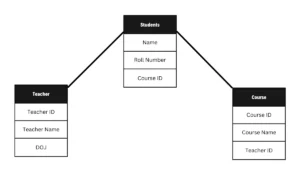Schema & Instance in DBMS
In a Database Management System (DBMS), the concepts of schema and instance help define the structure of the database and the actual data stored in it. Understanding these terms is essential for differentiating between the design of a database and the data it holds at a particular moment.
1. Schema
- A schema is the blueprint or design of a database. It defines the structure, such as tables, attributes (columns), data types, and relationships between tables.
- It is specified during the database design phase and remains constant over time unless modified intentionally by the database administrator.
- Schemas do not contain data; they only describe how the data will be organized and stored.
Analogy: Think of a schema like the architectural plan of a building. It defines the layout but doesn’t include the furniture or people living in it.

Example:
This SQL statement defines a schema for a Student table.
2. Instance
- An instance refers to the actual content of the database at a particular moment in time — the data stored in the tables.
- Unlike the schema, the instance changes frequently as data is inserted, updated, or deleted.
- A database can have multiple instances over time, but usually only one schema (unless altered).
Analogy: If the schema is the building’s design, the instance is what currently exists in that building — who lives there, what furniture is placed, and so on.
Example:
After inserting values into the Student table:
This is an instance of the Student table at that point in time.
Comparison Table
| Aspect | Schema | Instance |
|---|---|---|
| Definition | Structure of the database | Current content of the database |
| Nature | Static (infrequently changed) | Dynamic (changes frequently) |
| Contains | Table definitions, relationships | Actual data in tables |
| Example | CREATE TABLE statements |
Rows inside the table |
Conclusion
In summary, schema is the design or metadata of the database, while instance is the actual data. Distinguishing between these two helps in understanding database design versus database operation and data manipulation. Together, they form the core of how data is structured and managed in a DBMS.
